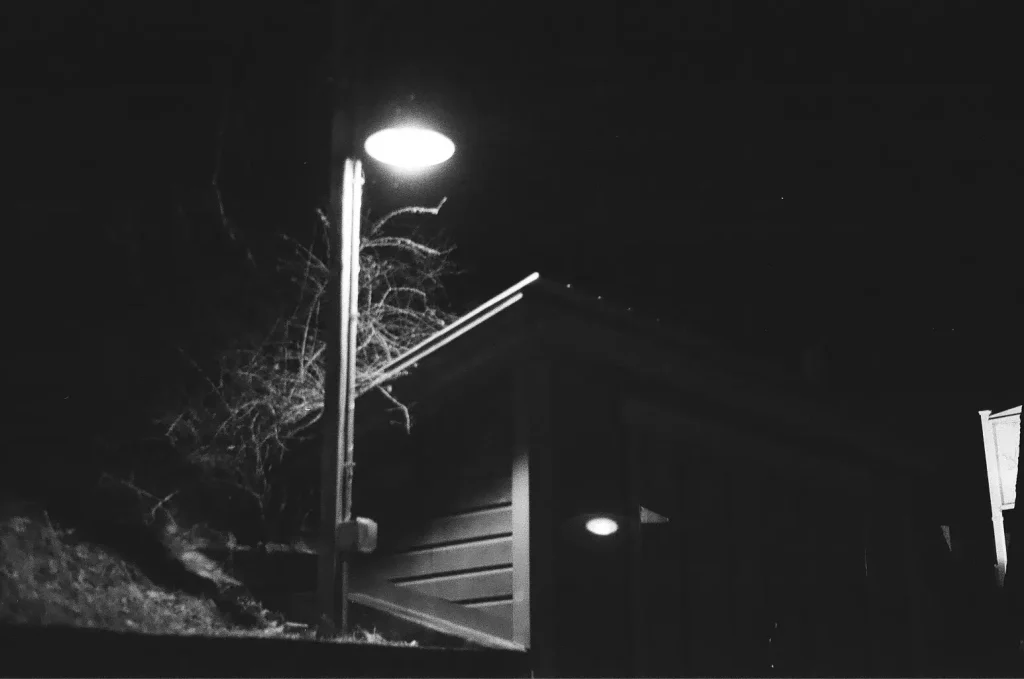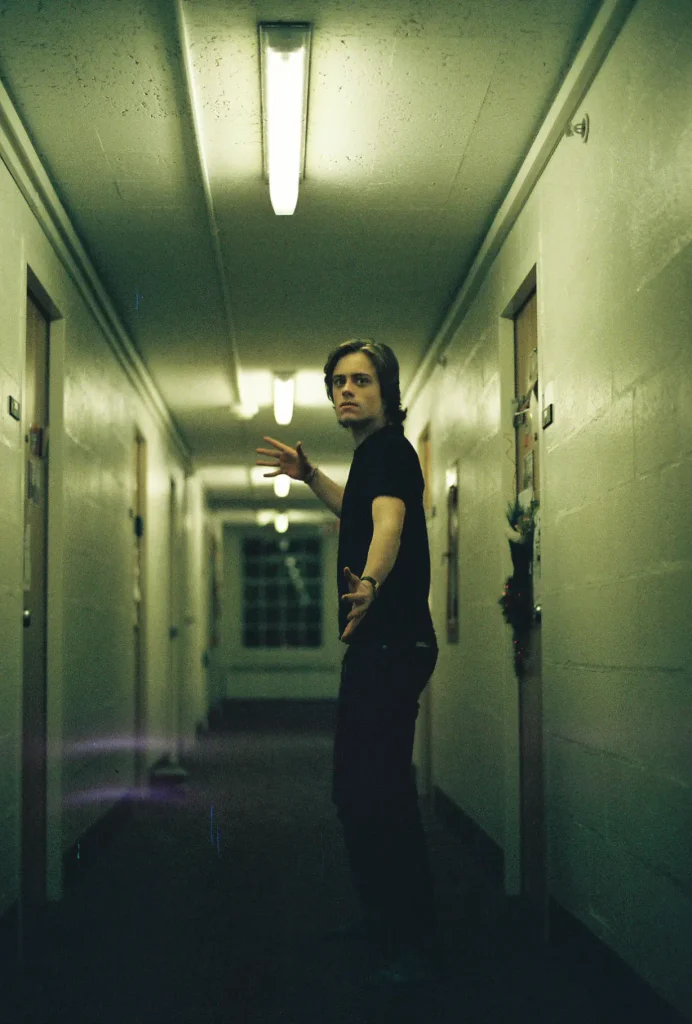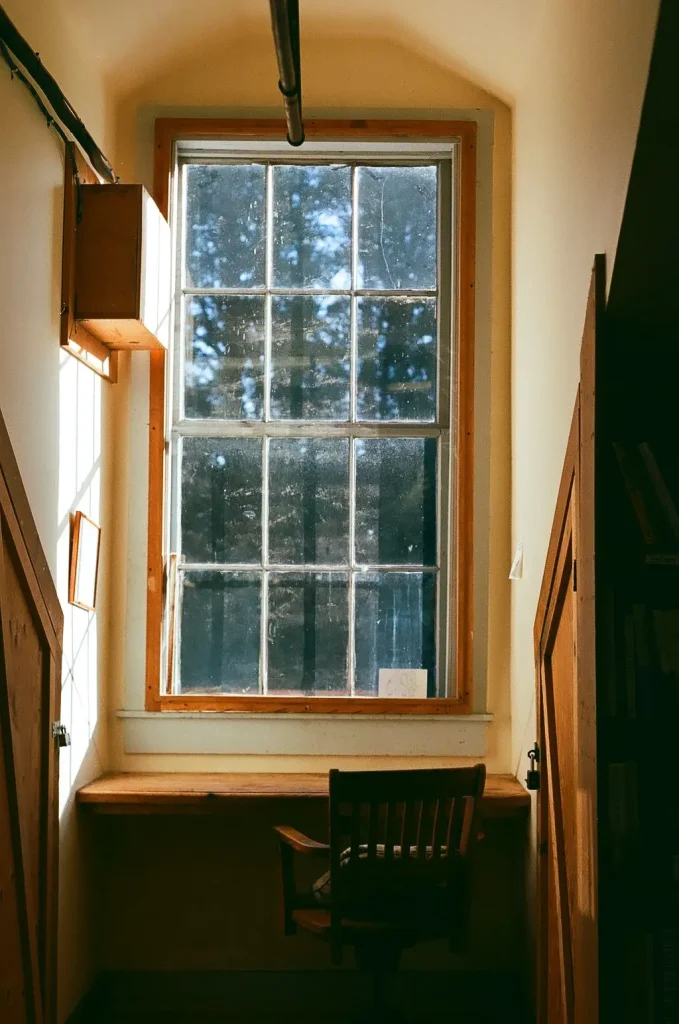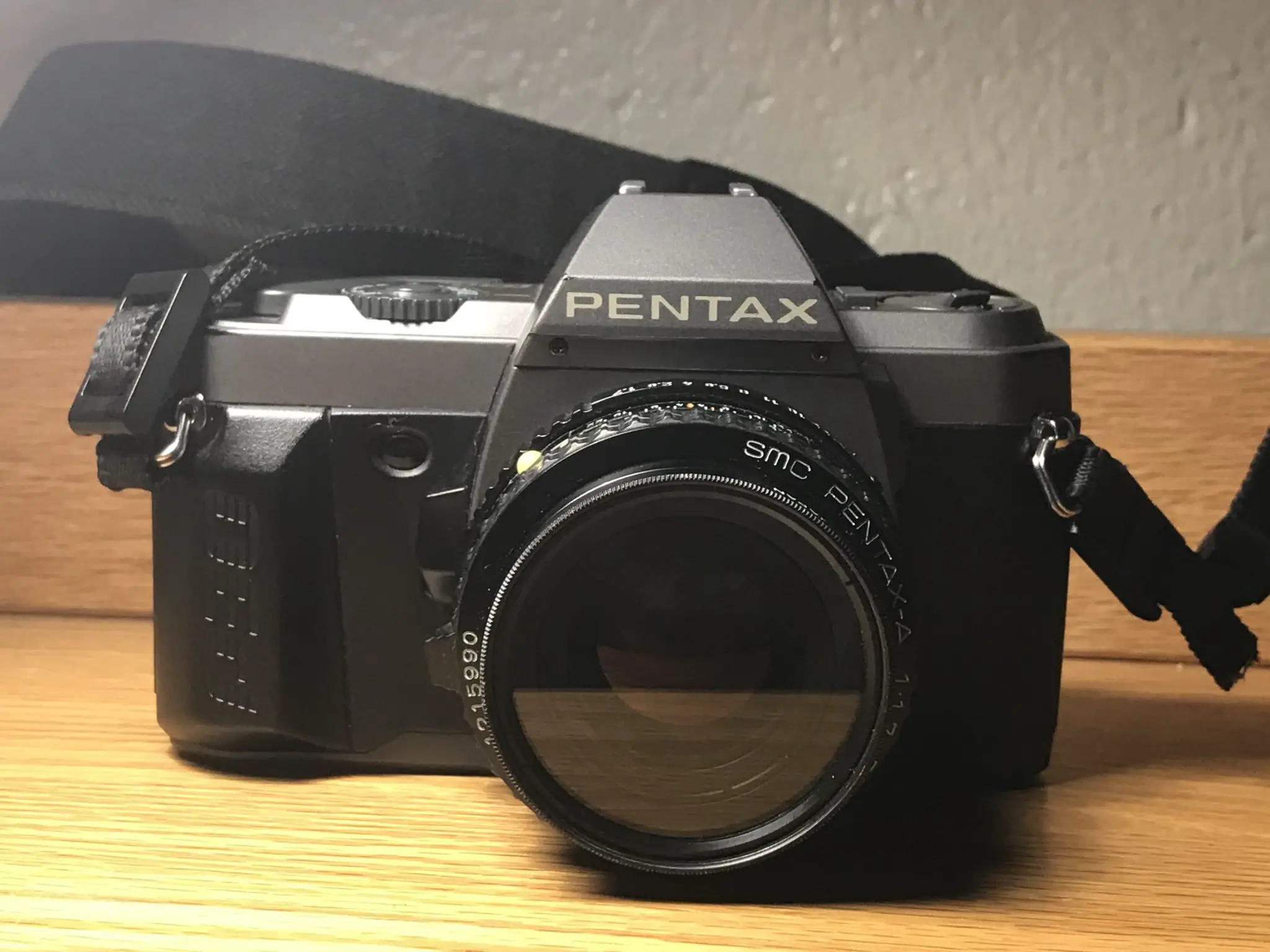The best camera, they say, is the camera you get for free. I still don’t know who “they” are, but I do know that I found my camera in the back of a dusty closet when I was moving away for my first year of college. My father told me to take it if I was so inclined, as he must’ve figured giving his camera to his son was better than having it rot away, unused. Now, after roughly 8 months of using it, I think I can shed some light on what I inherited.
What the box says
The Pentax P30t is not a groundbreaking camera, by any means. It’s a weird 90’s in-between of the earlier, all-metal manual focusing film cameras of the 70s & 80s and the newer, plasticky auto-focus ones that started popping up in the early 2000s. The P30t is manual focusing with either aperture priority or fully manual modes. The viewfinder is bright, with an LED screen that displays your shutter speed on the left. Shutter speeds are displayed in 2 colors; 1/30th and below are tinted orange in contrast to the green of 1/60th-1/1000th. An unfortunate drawback to the camera’s viewfinder is that your chosen aperture isn’t displayed, requiring eyes off to peek at the barrel of the lens. My favorite feature by far of the P30t’s is the viewfinder’s diagonal split screen. I find it a lot easier to align my shots with it than the horizontal split. The camera runs on two 357 silver-oxide batteries as the shutter operates on electricity.
Lightly depressing the shutter button will display the shutter speed. In “program” mode, a ‘P’ displays in the top left-hand corner. to signify the camera will take care of shutter speed & aperture automatically, though the aperture is not displayed (weirdly, an A isn’t displayed in aperture priority). In manual mode, an “M” is shown with two shutter speeds; your selected one is a solid light, while the camera recommendation blinks. It’s up to you to either follow the camera’s guidance and match the two speeds or forge your own path. Aperture Priority mode simply just shows the shutter speed the camera will shoot at.

The Pentax P30t has an odd choice of features it has and has not. Pentax K-mount lenses, a self-timer, hot shoe, depth of field preview lever, tripod mounting, and a thread on the side for a shutter release cable come standard here. I really do detest the fact that there is no manual ISO setting; instead, it reads DX codes. No DX code, the camera defaults at ISO 100. You don’t have a choice to over or underexpose film – at least without recoding the DX code.
It doesn’t have a lever for multiple exposures, nor exposure compensation dial, and the cable release shutter screws into a hole in the side of the lens mount, instead of the shutter button. But at the same time, it looks better somewhat then sticking straight out the shutter button. I think I’m nitpicking here.

The Pentax P30t shutter speed dial has enough resistance to make a gentle click every time you nudge it one way or another, and it’s not so stiff that you can’t turn it with your index finger. The film advance lever, similarly, moves smoothly enough to be content with, and with practice, I’ve been able to hit it with my thumb and advance in one clean, continuous motion. The shutter itself is louder than I’d like, and you’ll get noticed if your aim is to stay incognito. No praise here to Pentax engineers, but it’s something that doesn’t really break the camera, as much as it is getting used to the harshness of it.

However, the Pentax P30t does have a handy window in the backplate to read the tiny font on your film cassette, a bulge of sorts acting as an action grip on the right, and the memory lock function certainly is appreciated, if not underused. One weird quirk I found (don’t know if it’s just my camera) was that if you screw in a tripod adapter plate just the tiniest bit too much, the shutter won’t fire.
The only lens I’ve ever used with the Pentax P30t is the stock SMC Pentax-A 50mm f/1.7 lens. Though the automatic setting is there, I keep forgetting because I’m so used to the aperture-priority and manual modes. The lens is of plastic construction, and though it does kinda feel cheap, the clicks are satisfying enough, and the lens itself renders sharp. I’m not qualified to talk about the merits of lens sharpness; I’m just satisfied with the pictures I take, and though I do wish it was faster than f/1.7, I can get the job done most of the time with the right speed film.
What I say
I believe the gunmetal grey of the plastic compliments the camera’s looks well. It’s like I’m in Blade Runner or something carrying the thing around. Granted, I wouldn’t say it’s the most elegant thing to be hanging around your neck in the history of everything ever, but it certainly does take after an aesthetic. It’s not the silver and chrome of your AE-1s and K1000s, nor is it Giorgetto Giugiaro designed like the F3 is. But the camera invokes a low-profile workhorse, and I love it.
In my experience, the greatest strength of the Pentax P30t has been the weight. Despite my doubts about the plastic exterior, the camera holds up well enough, and I don’t feel like I have to baby it. I fancy myself something of a street and spur of the moment photographer and having something light to carry while I haul my laptop, notebooks and the occasional textbook is a blessing walking around campus. Its become something of a habit to carry the camera around for that one in a lifetime shot, but more often than not I shoot whatever catches my eye.

You line up a shot, make sure the shutter shown is green, fire, disengage your eye, throw the lever back, repeat. Certainly, it’s not flashy, but really, do I need flashy? The aperture-priority mode is where I’m comfortable with the Pentax P30t, with the perfect balance of speed and control. The meter’s accurate, and though the manual mode is finicky, I do find a use for it from time to time. People may dislike the LED in terms of the needle system, but, I appreciate the LEDs when I’m shooting pictures in buildings or low light.

In conclusion
The Pentax P30t is a small, light, comfortable camera that’s a bit underrated. I can’t stress how misleading the plastic exterior is in regards to the build quality; it’s going to survive most of the rigors of everyday life. I’ve carried this camera daily to my classes and back as well as on my expeditions to cities, mountains, forests, and everywhere in between for a semester and a half, and it’s proven to be a worthwhile companion. Stripping down to the bare minimum, I’ve used it as my main go-to camera and it does the job well. It’s compact and doesn’t get in the way when slung over your shoulder or around your neck, and the bodies and batteries for it go for real cheap. It’s perfect as a backup or primary camera, and the ease of use certainly lends itself to beginners as well as the more intermediate shooters out there. The Pentax P30t isn’t a pro-spec camera, but the camera doesn’t need to be to take gorgeous pictures.
If you really liked what I’ve said or what you’ve seen and you wanna see me more, I’m on instagram!
https://www.instagram.com/le.analog/
Share this post:









Comments
Lich on Pentax P30t review – The Middle Child – By William Le
Comment posted: 22/05/2019
Bluemark on Pentax P30t review – The Middle Child – By William Le
Comment posted: 22/05/2019
Jim on Pentax P30t review – The Middle Child – By William Le
Comment posted: 22/05/2019
Scott Edwards on Pentax P30t review – The Middle Child – By William Le
Comment posted: 22/05/2019
Martin Connolly on Pentax P30t review – The Middle Child – By William Le
Comment posted: 22/05/2019
Comment posted: 22/05/2019
Nige on Pentax P30t review – The Middle Child – By William Le
Comment posted: 23/05/2019
Aivaras on Pentax P30t review – The Middle Child – By William Le
Comment posted: 23/05/2019
Chris Routledge on Pentax P30t review – The Middle Child – By William Le
Comment posted: 23/05/2019
Dan Stevenson on Pentax P30t review – The Middle Child – By William Le
Comment posted: 23/05/2019
Alan Duncan on Pentax P30t review – The Middle Child – By William Le
Comment posted: 25/05/2019
Taylor Ervin on Pentax P30t review – The Middle Child – By William Le
Comment posted: 27/05/2019
Recommended reading : Down the Road on Pentax P30t review – The Middle Child – By William Le
Comment posted: 05/03/2020
Alex Novak on Pentax P30t review – The Middle Child – By William Le
Comment posted: 18/05/2020
Jim on Pentax P30t review – The Middle Child – By William Le
Comment posted: 25/05/2021
We always loved its light weight and split screen, and after 30 years it's still going.
Per Ole on Pentax P30t review – The Middle Child – By William Le
Comment posted: 11/11/2021
Paul C on Pentax P30t review – The Middle Child – By William Le
Comment posted: 17/09/2024
eBay is full of broken copies - and I understand the problem is the plastic gear train that gets brittle and for which there is no easy fix.
The plastic internal parts are a pain - but plastic external parts are useful - so many 30-40 year old cameras have corrosion, that this is now a virtue.
I've been able to add a range of k-mount prime lenses - all for the cost of 2x latte coffees at Starbucks or less per lens.
Other than getting K-mount Cosina/Miranda cameras (and yes, I do have 2 of those as well) I can't think of a cheaper way into creative film photography today.
Crucially it has what matters - a bright pentaprism for manual focus, a good range of shutter speeds, a meter that works to dusk, and a depth of field preview. and a trpod mount in the right place. Add a 28mm, 50mm and a 135mm prime and you have the classic range of perspectives covered.
Only trouble - how long will "affordable" film and processing and printing remain?